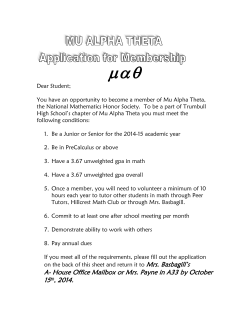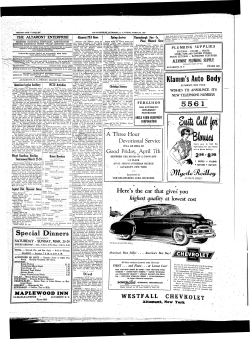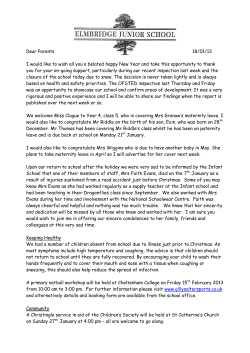
Virginia Woolf Life and Work
Virginia Woolf Life and Work Brief History Adeline Virginia Woolf (born Stephen; 25 January 1882 – 28 March 1941) was an English novelist, essayist, epistler, publisher, feminist, and writer of short stories, regarded as one of the foremost modernist literary figures of the twentieth century. During the interwar period, Woolf was a significant figure in London literary society and a member of the Bloomsbury Group. Her most famous works include the novels Mrs Dalloway (1925), To the Lighthouse (1927) and Orlando (1928), and the book-length essay A Room of One's Own (1929), with its famous dictum, "A woman must have money and a room of her own if she is to write fiction." Early life Virginia Woolf was born Adeline Virginia Stephen in London in 1882. Her mother, a famous beauty, Julia Prinsep Stephen (born Jackson) (1846–1895), was born in India to Dr. John and Maria Pattle Jackson and later moved to England with her mother, where she served as a model for Pre-Raphaelite painters such as Edward Burne-Jones.[1]. Her father, Sir Leslie Stephen, was a notable author, critic and mountaineer.[2] Early life The young Virginia was educated by her parents in their literate and wellconnected household at 22 Hyde Park Gate, Kensington. Her parents had each been married previously and been widowed, and, consequently, the household contained the children of three marriages. Julia had three children from her first husband, Herbert Duckworth: George, Stella, and Gerald Duckworth. Early life Leslie had one daughter from his first wife, Minny Thackeray: Laura Makepeace Stephen, who was declared mentally disabled and lived with the family until she was institutionalised in 1891. [3] Leslie and Julia had four children together: Vanessa Stephen (1879), Thoby Stephen (1880), Virginia (1882), and Adrian Stephen (1883). Early Life Sir Leslie Stephen's eminence as an editor, critic, and biographer, and his connection to William Thackeray (he was the widower of Thackeray's youngest daughter), meant that his children were raised in an environment filled with the influences of Victorian literary society. Henry James, George Henry Lewes, Julia Margaret Cameron (an aunt of Julia Stephen), and James Russell Lowell, who was made Virginia's honorary godfather, were among the visitors to the house. Early Life Julia Stephen was equally well connected. Descended from an attendant of Marie Antoinette, she came from a family of renowned beauties who left their mark on Victorian society as models for PreRaphaelite artists and early photographers. Supplementing these influences was the immense library at the Stephens' house, from which Virginia and Vanessa (unlike their brothers, who were formally educated) were taught the classics and English literature. According to Woolf's memoirs, her most vivid childhood memories, however, were not of London but of St. Ives in Cornwall, where the family spent every summer until 1895. The Stephens' summer home, Talland House, looked out over Porthminster Bay, and is still standing today, though somewhat altered. Memories of these family holidays and impressions of the landscape, especially the Godrevy Lighthouse, informed the fiction Woolf wrote in later years, most notably To the Lighthouse Early Life The sudden death of her mother in 1895, when Virginia was 13, and that of her half-sister Stella two years later, led to the first of Virginia's several nervous breakdowns. The death of her father in 1904 provoked her most alarming collapse and she was briefly institutionalised.[3] Her breakdowns and subsequent recurring depressive periods, modern scholars (including her nephew and biographer, Quentin Bell) have suggested,[4] were also influenced by the sexual abuse she and Vanessa were subjected to by their half-brothers George and Gerald Duckworth (which Woolf recalls in her autobiographical essays A Sketch of the Past and 22 Hyde Park Gate). Early Life Throughout her life, Woolf was plagued by periodic mood swings and associated illnesses. Though this instability often affected her social life, her literary productivity continued with few breaks until her suicide. Bloomsbury After the death of their father and Virginia's second nervous breakdown, Vanessa and Adrian sold 22 Hyde Park Gate and bought a house at 46 Gordon Square in Bloomsbury. Following studies at King's College, Cambridge,[5] and King's College London, Woolf came to know After the death of their father and Virginia's second nervous breakdown, Vanessa and Adrian sold 22 Hyde Park Gate and bought a house at 46 Gordon Square in Bloomsbury. Following studies at King's College, Cambridge,[5] and King's College London, Woolf came to know Lytton Strachey, Clive Bell, Rupert Brooke, Saxon Sydney-Turner, Duncan Grant, and Leonard Woolf, Leonard Woolf, Virginia Stephen married writer Leonard Woolf in 1912. Despite his low material status - Woolf referring to Leonard during their engagement as a "penniless Jew" the couple shared a close bond. Indeed, in 1937, Woolf wrote in her diary: "“Lovemaking — after 25 years can’t bear to be separate ... you see it is enormous pleasure being wanted: a wife. And our marriage so complete.”" The two also collaborated professionally, in 1917 founding the Hogarth Press, which subsequently published Virginia's novels along with works by T.S. Eliot, Laurens van der Post, and others.[6] The ethos of the Bloomsbury group discouraged sexual exclusivity, and in 1922, Virginia met the writer and gardener Vita Sackville-West, wife of Harold Nicolson. After a tentative start, they began a sexual relationship that lasted through most of the 1920s.[7 In 1928, Woolf presented Sackville-West with Orlando, a fantastical biography in which the eponymous hero's life spans three centuries and both genders. It has been called by Nigel Nicolson, Vita Sackville-West's son, "the longest and most charming love letter in literature."[7] After their affair ended, the two women remained friends until Woolf's death in 1941. Virginia Woolf also remained close to her surviving siblings, Adrian and Vanessa; Thoby had died of an illness at the age of 26 Suicide After completing the manuscript of her last (posthumously published) novel, Between the Acts, Woolf fell victim to a depression similar to that which she had earlier experienced. The onset of World War II, the destruction of her London home during the Blitz, and the cool reception given to her biography of her late friend Roger Fry all worsened her condition until she was unable to work.[8] On 28 March 1941, Woolf committed suicide. She put on her overcoat, filled its pockets with stones, then walked into the River Ouse near her home and drowned herself. Woolf's skeletonised body was not found until 18 April.[9] Her husband buried her cremated remains under a tree in the garden of their house in Rodmell, Sussex. In her last note to her husband she wrote: “I feel certain that I am going mad again. I feel we can't go through another of those terrible times. And I cant recover this time. I begin to hear voices, and I can't concentrate. So I am doing what seems the best thing to do. You have given me the greatest possible happiness. You have been in every way all that anyone could be. I don't think two people could have been happier 'til this terrible disease came. I can't fight any longer. I know that I am spoiling your life, that without me you could work. And you will I know. You see I can't even write this properly. I can't read. What I want to say is I owe all the happiness of my life to you. You have been entirely patient with me and incredibly good. I want to say that — everybody knows it. If anybody could have saved me it would have been you. Everything has gone from me but the certainty of your goodness. I can't go on spoiling your life any longer. I don't think two people could have been happier than we have been. V. [10] Modern scholarship and interpretations Recently, studies of Virginia Woolf have focused on feminist and lesbian themes in her work, such as in the 1997 collection of critical essays, Virginia Woolf: Lesbian Readings, edited by Eileen Barrett and Patricia Cramer. More controversially, Louise A. DeSalvo reads most of Woolf's life and career through the lens of the incestuous sexual abuse Woolf experienced as a young woman in her 1989 book Virginia Woolf: The Impact of Childhood Sexual Abuse on her Life and Work. Modern scholarship and interpretations Woolf's fiction is also studied for its insight into shell shock, war, class, and modern British society. Modern scholarship and interpretations Her best-known nonfiction works, A Room of One's Own (1929) and Three Guineas (1938), examine the difficulties female writers and intellectuals face because men hold disproportionate legal and economic power, and the future of women in education and society. Modern scholarship and interpretations Irene Coates's book Who's Afraid of Leonard Woolf: A Case for the Sanity of Virginia Woolf takes the position that Leonard Woolf's treatment of his wife encouraged her ill health and ultimately was responsible for her death. The position, which is not accepted by Leonard's family, is extensively researched and fills in some of the gaps in the traditional account of Virginia Woolf's life Modern scholarship and interpretations In contrast, Victoria Glendinning's book Leonard Woolf: A Biography, which is even more extensively researched and supported by contemporaneous writings, argues that Leonard Woolf was not only very supportive of his wife, but enabled her to live as long as she did by providing her with the life and atmosphere she needed to live and write. Modern scholarship and interpretations Accounts of Virginia's supposed anti-semitism (Leonard was a secular Jew) are not only taken out of historical context but greatly exaggerated. Virginia's own diaries support this view of the Woolfs' marriage.[26] Modern scholarship and interpretations Though at least one biography of Virginia Woolf appeared in her lifetime, the first authoritative study of her life was published in 1972 by her nephew, Quentin Bell. In 1992, Thomas Caramagno published the book The Flight of the Mind: Virginia Woolf's Art and Manic-Depressive Illness." Hermione Lee's 1996 biography Virginia Woolf provides a thorough and authoritative examination of Woolf's life and work. To the Lighthouse and Modernism Virginia Woolf, focuses on the inner lives of characters. The authors use differing strategies to construct a picture of an inner life (such as representing differing states of consciousness, or contrasting inner feelings with external realities). Modernity is identified with the rise of a "culture of consumption" in which a "hegemony of fashion and advertising" dominated a society defining itself increasingly in terms of leisure (Nicholls, 253). According to Lewis, a "society defining itself in terms of leisure is one in which life becomes increasingly aestheticised: "art" provides the collective representations of a "private" life which is founded in the rituals of imitation" (Nicholls, 252). ). Lewis perceived the "one-day world..(of).. advertisement" as a "plane universe, without depth" upon which "time lays down discontinuous entities, side by side; each day, each temporal entity, complete in itself, with no perspectives, no fundamental external reference at all" (Lewis, qtd Nicholls, 252 Woolf responded to the Modernist need to "reinvent constructive social narratives" to occupy the spaces opened up by Modernity (Nichols, 253). "Writing (came) to occupy a space between historical memory and imaginative construction" (253). Virginia Woolf emphasized the self's unstable existence in time "where time is not the time of some objective 'history' but the rhythm of feeling as it is scrutinised and overlooked by the perceiving mind" (Nicholls, 264). Woolf employs imagery as a strategy to depict instinctive reactions of her characters Woolf makes use of a multiplicity of narrators to capture the mental processes of her characters. A desire for connection between people is expressed by the depiction of altered states of consciousness in the two generations of female characters , which implies a process of evolvement from generation to generation. Woolf depicts the possibility of an evolved awareness that could connect people on a conscious level. The Stream of Consciousness Technique in To the Lighthouse In Virginia Woolf's case the exterior events have actually lost their hegemony, they serve to release and interpret inner events, whereas before her time (and still today in many instances) inner movements preponderantly function to prepare and motivate significant exterior happenings" (Auerbach 475) In his 1946 work Mimesis: The Representation of Reality in Western Literature, German critic Erich Auerbach argues that To the Lighthouse demonstrates author Virginia Woolf’s ability to invert the traditional causal relationship between the actions that make up the plot of the novel and the thoughts of the various characters (475). In “The Brown Stocking” Auerbach elaborates in detail the insignificance of exterior occurrences to interior processes as established in the narrative form of Virginia Woolf’s To The Lighthouse. In the passage Auerbach quotes from the novel, Woolf presents a discrepancy between physical and subjective dimensions – characterizing Mrs Ramsay by a mode of multiplicity (performing various tasks enabling the exterior events without neglecting the more significant inner events represented by her thoughts, Woolf creates synchronic dimensions(concerned with events existing in a limited time period and ignoring historical antecedents) in a diachronic(phenomena (as of language or cultureas they occur or change over a period of time) narrative, a “multipersonal representation of consciousness” that is evident also in the art of the modernist period. Monet’s “Water Garden and Japanese Footbridge”, for example, portrays a similar multiplicity of reality in that the emphasis on light and how it changes our emotions and perceptions is more significant than the external image itself. Rejecting the idea of one fixed reality, a characteristic of modern art is it prompts for an investigation of objective reality by means of subjective impressions received by various individuals and at various times. This multiplicity that characterizes the modernist crisis of representation seems to register the breakdown of traditional certainties and the attempt to construct alternative meaning and order. In general, the works that emerged out of the period reflect a radical breakaway from traditional methods of representation. There is no longer a fixed center, perspective or meaning to be found, let alone a proper solution or closure to the proposed issues, hence Auerbach’s suggestion that “there is often something confusing…hazy about them, something hostile to the reality which they represent” (p.551, “The Brown Stocking”). From Pablo Picasso to Virginia Woolf, the modernist artists seem intent to demonstrate an inherent sense of disorder and disunity in their works. Mrs. Ramsay’s world is directed forward by the particular and concrete, the fragrance of the Boeuf en Daube and the strength of another’s arm. Each particularity, each concrete aspect of life is unique, with its own history and distinct relationship with a thinker.13 Even the Boeuf en Daube is not common, generalized entity. The aroma and the taste vary with each person. The preparation and the memories of other times, other dinners, and other recipes contribute to each person’s understanding of and relationship with the present Boeuf en Daube. Even more than the Boeuf en Daube that Mrs. Ramsay serves to her dinner guests, there is the concreteness and particularity of each person, each of the guests, each of her children as a distinct, concrete person with a life history, a narrative, with abilities, dreams and hopes, with needs, interests, feelings, and desires, with a preferred way of thinking, with different vocabularies and texts to enrich his or her life. Knowledge of the other, whether person or object, is not based on fragmented parts, on some additive process by which separate, unconnected facts are combined. As Woolf says elsewhere, “It is no use trying to sum people up. One must follow hints, not exactly what is said, not yet entirely what is done.”14 When she sees her children smiling, running, or playing, when she wonders whether Minta Doyle will marry Paul Bayley and the suitability of this choice, Mrs. Ramsay is not analyzing a smile, a judgment, or an instance of behavior. A so-called instance of behavior is akin to William Blake’s epigram “To see a world in a grain of sand [and]…. Hold Infinity in the palm of your hand.”15 However, it is not Infinity with a capital “I” that Mrs. Ramsay sees in her child’s eyes. It is a world that is James, her son. Though this form of knowledge and thinking at first seems ephemeral and unstable, it can be described in a number of ways, as intuitive knowledge and tacit knowing. As with intuition, Mrs. Ramsay does not lack knowledge Her knowledge and thinking are not empty or unexplainable. Though a mother’s understanding of her infant’s needs and desires may be called intuitive or a maternal instinct, this understanding is based on a form of knowledge and way of gaining knowledge. There is intense concentration on and involvement with the other and with the other’s world. This concentration is not just hearing words and interpreting or translating their meaning into logical, propositional form. It is listening, the seeing, the grasping, the feeling, the encounter. At the same time that this knowing person remains herself and retains her knowledge and entering the place of the other while yet not defining that place. Relationships form the core of the world Mrs. Ramsay inhabits. Problems requiring caring, responsiveness, communication, tangled networks of concern, emotions, and the avoidance of betrayal or isolation,16 and the understanding of another’s life history emerge from these relationships. According to Blum, for example responsiveness involves both cognitive and affective dimensions. It includes a cognitive grasp of another’s condition…. At the same time the altruistic aspect of responsiveness involves our emotional natures, in that responsiveness is not a purely rational willing of another person’s good.17 Though the language of care and response requires one to nurture and respond to the other and not to hurt either the other or oneself, it also necessitates demystification, openness, and a rejection of self-deception. As we read To the Lighthouse, we recognize the two ways of thinking about and relating to the world, others, and ourselves. We take Mrs. Ramsay’s perspective and become part of the world that she inhabits. We experience the loss and desperation of Mr. Ramsay after the death of Mrs. Ramsay. We may wonder whether his loss was the loss of Mrs. Ramsay or not having everything in its place, not having someone to take care of his mundane world, and not having the comfort of the ordinary. Mr. Ramsay never searches to know the other world and way of life that Mrs. Ramsay personified. Mr. Ramsay never questions whether at times he too should enter into this other way of knowing and thinking. Though men’s language provides a “heaven of security” for her life, Mrs. Ramsay does not presume she should speak this foreign language or enter men’s world; she does not entertain the idea that this too should be her world. But just as the second and third sections of To the Lighthouse are fraught with darkness and foreboding, the resonance of this feeling reverberates back to expose the despair and forewarning in the first section. Even from behind the protective shield of “The Window,” the melancholy, frustration, and resentment of “Time Passes” and “The Lighthouse” are felt. The foreboding and darkness emanate from below the surface and are not just based on the sudden death of Mrs. Ramsay, the shell that kills Andrew, the death of Prue in childbirth, the loneliness of Mr. Ramsay, and the bitterness of James. In the section, “The Window,” we are often struck by what is not said, by what is missing. In the either - or categories personified by Mr. Ramsay and Mrs. Ramsay, we are led to recognize the uneasiness that Lily Briscoe feels and the discomfort of Bankes at having to dine with the Ramsays. Mrs. Ramsay herself poses one of the problems that bothers us. When Bankes speaks of friends Mrs. Ramsay has not seen for many years, Mrs. Ramsay cannot believe that they still exist, that they have led their own life, throughout these years, a life she knew nothing of. Maybe, we can even say that she cannot imagine that there are other voices and themes, other moral songs and ways of living beside the one that she knows so well.18 She never entertains the idea that caste, social class, and economic system, race specific experiences, cultural or historical setting, and ideological differences, like language itself, may generate different, equally acceptable ways of living and thinking. Even Mrs. Ramsay’s empathy with the crying chambermaid whose father is dying so far away, in Switzerland, is not a case of universality, but the nearness of the young maid. The thinness of Mrs. Ramsay’s visits to the poor and needy are like the stocking she knits for the lighthouse keeper’s son. They are all part of ha goodness, but it is a goodness that does not have to confront the realities of these others. Mrs. Ramsay’s caring for others focuses on face-to-face encounters with those who are intimates family, friends, and all of those who are part of her daily life. Caring, response, knowledge, and thinking, for Mrs. Ramsay, focus on a very limited population, on those people, events, and occasions when she can directly affect those who hear her voice and feel her presence. There is something equally tragic about Mrs. Ramsay’s portrayal of life. Even Mrs. Ramsay herself wonders if she is too overpowering and overprotective, whether her caring at times smothers others, whether her view of what someone else’s life should be is mistaken Do the ones she believes need caring for really need the care she gives? She orchestrates the marriage of Minta and Paul, thinks about whether Lily Briscoe and William Bankes should marry, wonders about the fate of Charles Tansley as a scholar who follows in the footsteps of ha husband, only imagines ha daughters’ future in terms of marriage. But Mrs. Ramsay’s dreams, her caring and responsiveness, come to naught. Paul’s marriage does not measure up to the ideal match it promised to be on the day Minta lost her grandmother’s brooch and became engaged to Paul. Lily Briscoe never marries, but attains ha own identity in a way Mrs. Ramsay could never imagine. And Charles Tansley during the Great War to end all wars gives speeches about love, not about logic or the scholarship Mr. Ramsay so revered. What does this tell us? To say that care, as with any other moral standard or standard of rationality, is fallible or that life has a deeply tragic vein would be to say the obvious. Instead, there is something else. With the passage of time, with the transformation of Charles Tansley and of Lily Briscoe, we also recognize how time, the vast sweep of personal and public historical events also requires us to change and reconceptualize our intellectual concepts, the way we look at reasoning and morality. At present, a few writers suggest that what some may call masculine reasoning and a masculine moral language are thus being reconceptualized to include aspects of the feminine. The either/or categories represented by Mr. Ramsay and Mrs. Ramsay are now being shown to be partial and anemic. If we accept, for example, caring, as a quality, a virtue that imbues the presence and life of someone like Mrs. Ramsay, then we must also think about what other virtues are required to give that one virtue breadth and meaning, disclose its inner core. Instead, any one moral virtue refers to a coherent set of other, interconnected virtues. For example, caring for someone requires the virtue of courage since caring for often requires acts that are out of the ordinary, that encounter and overcome something someone may fear. At times, we are distressed at Mrs. Ramsay’s silence, at her neutrality, in the face of Mr. Ramsay’s unfeeling response to his children and we wonder why Mrs. Ramsay’s paralysis, why her silence, her ina bility to speak, and to defend her children. Similarly, justice would be a cold, a frigid virtue, as unresponsive and austere as Mr. Ramsay often was, if it did not possess care and compassion. In addition, feminine theorists need to provide a richer interpretation of community, instead of favoring the idea of “concentric circles,” networks, and webs of relationships. However, when feminine ethical theory stresses life history and narrative, it cannot only speak of a person’s life from the time of birth. Instead, these theories must recognize as Virginia Woolf did, that at the time of birth, the infant does not merely relate to caregivers, family members, and other intimates. The Ramsay family is not disassociated from some larger framework. We recognize this family as the same family described in the Godless Victorian,the biography of Leslie Stephen, Virginia Woolf’s father and the model for Mr. Ramsay. This family like any other family is not a selfcontained network or web of interacting relationships. Rather, in the background and within its very being, there is an explicit or tacit community that contributes to the education of the infant her life history, and the way she chooses a life narrative. The content and meaning of our interlocking system of moral virtues must then be found in the history, the memories of communal life. These communal roots contribute metaphors, symbols, meanings, skills, values, excellences, virtues, and interests to those who nourish and care for an infant. These moral virtues acquire substance and meaning through being part of a region, a community. Modernist Style of Writing. One does not have to read very much of To the Lighthouse before one realizes that Woolf has chosen here a very particular style, a way of telling the story which exerts a strange and compelling effect upon the reader in order to consider some of the ways in which a few very important aspects of what this novel has to reveal are directly linked to the author's decisions about point of view and language. One of my major purposes in this lecture is to offer some suggestions about why we might consider Woolf a major modernist writer and link her to other modernist artists we have been considering in Liberal Studies, even to those who, at first glance perhaps, don't seem to share quite the same style: Kafka, Eliot, and certain modern painters. I shall be trying to establish as my major point the idea that what does link Woolf to these other modernists is the way in which her style compels us to recognize a fundamental problem of modern life: the deep and apparently unbridgeable dichotomy between the fragmented inner world of the self and any sense of coherent order to the world beyond the self, that is, the world of human relationships, of nature, of society as a totality. The Power of Style: An Example This particular example is part of a description of Mrs Ramsay : All she could do now was to admire the refrigerator, and turn the pages of the Stores list in the hope that she might come upon something like a rake, or a mowing machine, which, with its prongs and its handles, would need the greatest skill and care in cutting out. All these young men parodied her husband, she reflected; he said it would rain; they said it would be a positive tornado. But here, as she turned the page, suddenly her search for the picture of a rake or a mowingmachine was interrupted. The gruff murmur, irregularly broken by the taking out of pipes and the putting in of pipes which had kept on assuring her, though she could not hear what was said (as she sat in the window which opened on the terrace), that the men were happily talking; this sound, which had lasted now half an hour and had taken its place soothingly in the scale of sounds pressing on top of her, such as the tap of balls upon bats, the sharp, sudden bark now and then, "How's that? How's that?" of the children playing cricket, had ceased; so that the monotonous fall of the waves on the beach, which for the most part beat a measured and soothing tattoo to her thoughts and seemed consolingly to repeat over and over again as she sat with the children the words of some old cradle song, murmured by nature, "I am guarding you--I am your support," but at other times suddenly and unexpectedly, especially when her mind raised itself slightly from the task actually in hand, had no such kindly meaning, but like a ghostly roll of drums remorselessly beat the measure of life, made one think of the destruction of the island and its engulfment in the sea, and warned her whose day had slipped past in one quick doing after another that it was all ephemeral as a rainbow-this sound which had been obscured and concealed under the other sounds suddenly thundered hollow in her ears and made her look up with an impulse of terror. The first thing we notice about this style, I suspect, is the extraordinary sentence structure. The second paragraph contains a sentence of 260 words, a sentence which, in effect, is a single complex sentence of 32 words enormously embellished by parenthetical phrases and clauses, modifying phrases, and a whole rich array of various grammatical constructions These hold up the full meaning of the sentence and transform it from something clear and straightforward into something delayed, qualified, uncertain, and (for the reader) much more difficult to assimilate. If we examine closely the structure of that long sentence, we see that the main clause begins with an indication of the subject (the gruff murmur) but that any further development of that clause is held up for nine lines, so that we get a range of associations and modifying phrases describing that murmur. Thus, by the time we get to the main verb (had ceased) we have gone through a range of emotional associations connected to the initial subject. The meanings of the words and, most important, the rhythm of the sentence establish the extent to which Mrs Ramsay's mood is dependent upon the semi-conscious absorption of what is going on around her. She cannot hear what people are saying, but the very presence of the regular activity provides for her a comforting reassurance of domestic order. Thus, the structure of the sentence itself presents the central issue of Mrs Ramsay's character, that she is constantly dependent upon the existence of family rituals all around her, that, although she may not participate directly in them or even be fully aware of what is going on, she relies upon such a background sense of ongoing domestic order to sustain her tranquil mood. The strongest word in the entire sentence is the final word terror. It injects into what has seemed a slow meandering through a number of quotidian details a sudden emotional urgency. We can ask ourselves an obvious question: Why does Woolf not simply present the main clauses and thus deliver the full thought much more simply? After all, isn't the main point here that Mrs Ramsay's mood changes suddenly in an unwelcome way? However, what goes on in her mind, from one moment to the next, is something much more complex than any such simple declaration would illustrate. More about this later. We notice, too, how almost all the details of this style focus our attention upon what is going on in Mrs Ramsay's mind. We do learn some external details about what she is doing and where she is sitting, but these details are clearly subordinated to the most obvious content of the sentences: the details passing through Mrs Ramsay's consciousness as she sits and stares at a magazine, half-listening to the children playing and the men talking nearby. In other words, there's an interplay here between the external world and Mrs Ramsay's inner consciousness of that world, but the emphasis is very much on the latter rather than on the former. Such a style, in other words, forces us to recognize the preeminence of the inner life in the ongoing drama of a human existence. No one thinks in such superbly polished prose, taking care, clause by clause or phrase by phrase, that all the antecedents are appropriately positioned and the modifiers clear. No, if people thought like this, then English teachers would be out of a job. What Woolf is attempting here clearly is not to reproduce the thought process itself but to develop a symbolic equivalent of thought, to use her command of English prose style to create for us in the rhythm, structure, and accumulation of detail in the sentence an emotional illumination of Mrs Ramsay's consciousness. A comparison here with symbolist painting may be in order. What the symbolist (like, say, Dali) is doing is using his art to create for the viewer the emotional equivalent of dreams, to get us to recognize in the art something analogous to a dream experience. But in creating such symbols, the painter, like Woolf, is doing something very sophisticated and simply beyond the world of how people really think and how they dream. The structure of the sentence also characterizes that inner life in a curious way that is sustained for all of the characters in the novel. We can summarize this briefly by observing that characteristically the people in this novel, as in the above example, cannot complete a simple and coherent thought without a host of other impressions, memories, feelings, images, qualifications, and possibilities crowding in upon the mind. The essential quality of life here is inner, and in that inner world the emotional changes can be abrupt, unexpected, and extreme. There is nothing particularly dramatic in the external scene; it is about as tranquil and unthreatening as a domestic scene might be--a family at play and rest. Yet there is an intense inner drama amid all this mundane detail. Woolf does not tell us that the real drama of life is inner, but the structure of the sentences forces us to acknowledge that as the major fact of life: one can go from security to dread in an instant for reasons one cannot fully comprehend. This style also indicates that the succession of thoughts is not in Mrs Ramsay's control. The style is, of course, beautifully controlled, but its effect on the reader is a constant feeling of surprise, complexity, and lack of control on the part of Mrs Ramsay To appreciate the significance of what Woolf is doing we might think for a moment about the relationship in other books we have read between the inner world of the characters and their perceptions of the outer world. In Homer, for example, the characters have a firm confidence in the external world. It may be unpredictable and often brutal, but they are confident that they understand why it is so (the gods, everyone agrees, are in charge). Hence, nature and society have a certain stability of meaning, and human beings can understand themselves with reference to that natural order. However, this great confidence in the congruence of inner and outer sources of meaning was decisively challenged in the seventeenth century. In the work of Descartes, who urges us to distrust all contact with the external world, to direct our attentions inward, and to build whatever we can know upon a ruthless self-examination. Only if we do that, can we come to any serious understanding of ourselves and the world. Now, this inward turn, as we have discussed, creates a dichotomy between the inner self and the outer world, between mind and matter, between the thinking, feeling subject and the perceived objects of experience, and calls into question the traditional faith in understanding the self in terms of a wider natural order given by God. The sense of a separation is alienation, which, in the most general sense, refers to a feeling that one's full identity as imagined inside is not part, or not sufficiently part of one's real existence in the given world. Alienation Now, one characteristic feature of a good deal of Modernist art is the recognition that such an attempt to resolve the question of alienation is futile. The self has become so fractured and the world has become so unknowable or so strange that the possibilities for connecting a sense of who I am as a human being with some wider purpose for life itself no longer exist. Kafka's prose in The Metamorphosis There the weird and horrific events are given to us, largely from the point of view of Gregor's own mind, in a flat, unemotional, and prosaic style quite at odds with the strangeness of the situation. One effect of this is to underscore just how inadequate Gregor's mind is to gain any sense of the reality of the situation he or any of his family is in, and, beyond Gregor, a sense of how language itself cannot capture the full meaning of these events. There is no closure. Woolf is, in a sense, doing the same thing. Here the events surrounding the characters are anything but weird--this novel is full of what should be cozy domesticity: a family holiday in a beautiful setting, full of friends, children, communal get-togethers, drinks, dinners, walks along the beach. But the style is wholly inappropriate to such a view of the events, for the style insists upon the dramatic complexity, unpredictability, painful tensions, and dangers inherent in every minor social turn Like Gregor, Mrs Ramsay and others in the novel want closure. Big questions keep insisting on raising themselves: What is the meaning of life? But the thought processes, as revealed in the style, show that no answer to such a question is possible, since no quiet and complete thinking is possible. There are always the interruptions from outside, from the memory, from associations, from buried feelings. How can one achieve any form of closure, when the personality who is asking the questions is incapable of holding onto a firm sense of itself, of controlling what is going on? Even Mr Ramsay, famous throughout the country for the power of his logical mind, cannot control his own sense of himself and is as subject as everyone else to the sudden terrors of an unexpected thought or feeling which, as often as not, is resolved equally unexpectedly Another way of making this point is to stress that these modernist characters experience life as a flux, a disordered succession of inner thoughts, ambitions, hopes, desires, fears, something over which they exercise no firm control. In a moment there is time for decisions and revisions which a minute will reverse. Having no reassuring sense of a permanent order, they have nothing to measure themselves against, no firm model of who they are, socially or individually. Thus, they are defined by the emotions and memories and impressions of each passing moment. And they are helpless in front of the major questions of life, like "What is the purpose of life?" or "What have I done with my life?" or "What is happening to me?" They cannot face these questions because they cannot deal with life as a totality, since they experience it as a ceaseless flux of often dissociated impressions, unwelcome memories, desires (many of which go unsatisfied), and fears. So we get the sense of characters, isolated individuals, who endlessly introspect, wondering about their identity, the meaning of their lives, the significance of their feelings. Often they raise these questions only on the inside, sometimes in the midst of the most mundane activities (like Mrs Ramsay). Generally, the questions don't get taken into anything like a community forum, simply because there isn't such a forum, and in some cases, as in Gregor's, such communication is impossible; in others, like Prufrock's and Mrs Ramsay's, social conventions stand in the way of an open confession about one's deepest concerns before others (who in any case would probably be incapable of assisting, because they are wrestling in the same inner space with the same questions). The result is that they seem to live much of their lives picking away at the leaves of their own psyches, searching for some final significance. The effect, to borrow a metaphor from Ibsen's Peer Gynt, is like peeling an onion. Every layer one removes reveals another one underneath; and if one persists to the very centre, there's nothing there but empty space. The Fragmented Self The "fragmented self" is a particular concern of Modernist writers. It's clear that there is no possibility in their world of the old social self, since the shared communal understanding of value upon which that depends has disappeared. It's true that Mrs Ramsay devotes her whole life to a project of conferring social value on people, seeking always to place people in appropriate traditional social arrangements, like guests at her home or table or partners in a marriage. But her society is too complex, too transitory, too vulnerable to provide any more, as it does in Homer or Shakespeare, a firm grounding for one's sense of who one is. In that sense, Mrs Ramsay is clearly a figure from the past, whose understanding of life, whose grasp on events, is shaped entirely by her ability as a social being to establish meaningful relationships among people. Viewpoint one regards life: Whether the detached philosopher or housewife (thesis) One must give up the first prespective in favour of the other (antithesis) Becoming immersed in the waters of trnsition emerging with a double vision(synthesis) Joseph Conrad Early Life Joseph Conrad (born December 1857 – 3 August 1924) was a Polishborn British novelist, who became a British subject in 1886. He is regarded as one of the greatest novelists in English,[2] though he did not speak the language fluently until he was in his twenties (and then always with a marked Polish accent). Early Life He wrote stories and novels, predominantly with a nautical or seaboard setting, that depict trials of the human spirit by the demands of duty and honor. Conrad was a master prose stylist who brought a distinctly non-English tragic sensibility into English literature. While some of his works have a strain of romanticism, he is viewed as a precursor of modernist literature. His narrative style and anti-heroic characters have influenced many authors. Films have been adapted from or inspired by Conrad's Victory, Lord Jim, The Secret Agent, An Outcast of the Islands, The Rover, The Shadow Line, The Duel, Heart of Darkness, and Nostromo. Writing in the heyday of the British Empire, Conrad drew upon his experiences in the French and later the British Merchant Navy to create short stories and novels that reflect aspects of a worldwide empire while also plumbing the depths of the human soul. Early life Joseph Conrad was born in Berdyczów (now Berdychiv, Ukraine) into an impoverished, highly patriotic Polish noble family bearing the Nałęcz coat-of-arms. His father Apollo Korzeniowski was a writer of politically-themed plays and a translator of Alfred de Vigny, Victor Hugo, Charles Dickens and Shakespeare from French and English. He encouraged his son Konrad to read widely in Polish and French In 1861 the elder Korzeniowski was arrested by Imperial Russian authorities in Warsaw for helping organize what would become the January Uprising of 1863–64, and was exiled to Vologda, a city some 300 miles (480 km) north of Moscow. His wife Ewelina[ Korzeniowska (née Bobrowska) and four-year-old son followed him into exile. Due to Ewelina's weak health, Apollo was allowed in 1865 to move to Chernihiv, Ukraine, where wıthin a few weeks Ewelina died of tuberculosis. Apollo died four years later in Kraków, leaving Conrad orphaned at the age of eleven. Voyages Conrad lived an adventurous life, dabbling in gunrunning and political conspiracy, which he later fictionalized in his novel The Arrow of Gold. Apparently he experienced a disastrous love affair that plunged him into despair. A voyage down the coast of Venezuela would provide material for Nostromo; the first mate of Conrad's vessel became the model for that novel's hero. In 1878, after a failed suicide attempt in Marseille by shooting himself in the chest,[6] Conrad took service on his first British ship, bound for Constantinople before its return to Lowestoft, his first landing in Britain. Barely a month after reaching England, Conrad signed on for the first of six voyages between July and September 1878 from Lowestoft to Newcastle on a coaster misleadingly named Skimmer of the Sea. Crucially for his future career, he "began to learn English from East Coast chaps, each built to last for ever and coloured like a Christmas card." In London on 21 September 1881 Conrad set sail for Newcastle as second mate on the small vessel Palestine to pick up a cargo of 557 tons of "West Hartley" coal bound for Bangkok. From the outset, things went wrong. A gale hampered progress , then the Palestine had to wait a month for a berth and was finally rammed by a steam vessel. In 1886 he gained both his Master Mariner's certificate and British citizenship, officially changing his name to "Joseph Conrad." Prior to his retirement from the sea in 1894, Conrad served a total of sixteen years in the merchant navy. In 1883 he joined the Narcissus in Bombay, a voyage that inspired his 1897 novel The Nigger of the Narcissus. A childhood ambition to visit central Africa was realised in 1889, when Conrad contrived to reach the Congo Free State. He became captain of a Congo steamboat, and the atrocities he witnessed and his experiences there not only informed his most acclaimed and ambiguous work, Heart of Darkness, but served to crystallise his vision of human nature — and his beliefs about himself. These were in some measure affected by the emotional trauma and lifelong illness he contracted there. During his stay, he became acquainted with Roger Casement, whose 1904 Congo Report detailed the abuses suffered by the indigenous population. The journey upriver that the book's narrator, Charles Marlow, made closely follows Conrad's own, and he appears to have experienced a disturbing insight into the nature of evil. Conrad's experience of loneliness at sea, of corruption and of the pitilessness of nature converged to form a coherent, if bleak, vision of the world. Isolation, self-deception, and the remorseless working out of the consequences of character flaws are threads running through much of his work. "Amy Foster." Conrad's own sense of loneliness throughout his exile's life would find memorable expression in the 1901 short story, “Amy Roster”. In March 1896 Conrad married an Englishwoman, Jessie George. He subsequently lived in London and near Canterbury, Kent. The couple had two sons, John and Borys. Style Conrad, an emotional man subject to fits of depression, self-doubt, and pessimism, disciplined his romantic temperament with an unsparing moral judgment. As an artist, he famously aspired, in his preface to The Nigger of the 'Narcissus' (1897), "by the power of the written word to make you hear, to make you feel... before all, to make you see. That — and no more, and it is everything. If I succeed, you shall find there according to your deserts: encouragement, consolation, fear, charm — all you demand — and, perhaps, also that glimpse of truth for which you have forgotten to ask."[13] Writing in what to the visual arts was the age of Impressionism, Conrad showed himself in many of his works a prose poet of the highest order: thus, for instance, in the evocative Patna and courtroom scenes of Lord Jim; in the "melancholy-mad elephant" and gunboat scenes of Heart of Darkness; in the doubled protagonists of The Secret Sharer; and in the verbal and conceptual resonances of Nostromo and The Nigger of the 'Narcissus'.
© Copyright 2025











